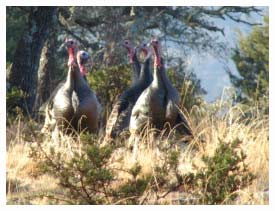Hunting Tips, Questions, Stories & Discussion
Focusing on managing Texas wildlife habitat and natural resources for native and exotic wild game species, for this and future generation of hunters and outdoor enthusiasts.Thursday, January 15, 2009
Where did the name Rio Grande come from for this Texas turkey species?
 Although the Rio Grande River only goes through a portion of Texas, it is perhaps the best known waterway in the state. The Texas turkey, which is the Rio Grande species, is named for its attraction to the riverbeds and areas along the Rio Grande River. They use cottonwood trees for roosting, so the moist and lowland areas along the river provide the perfect natural nesting area.
Although the Rio Grande River only goes through a portion of Texas, it is perhaps the best known waterway in the state. The Texas turkey, which is the Rio Grande species, is named for its attraction to the riverbeds and areas along the Rio Grande River. They use cottonwood trees for roosting, so the moist and lowland areas along the river provide the perfect natural nesting area.Besides being found in Texas this turkey species is also common in Oklahoma, New Mexico, Nevada, Washington, Wyoming, Oregon, Utah, South Dakota, California, Kansas and the northeastern part of the country of Mexico. Texas has the largest wild and managed population of Rio Grande Turkeys with an estimated number of over 600,000. They tend to be found only in areas where there is some form of natural water, however many venture miles from the river, stream or waterway during their travels.
Are Texas turkeys confined at Escondido Ranch?
The turkeys are able to move about through the ranch, however they are not confined by the game fence. Since the birds are rather nomadic and move from summer and winter feeding areas they have free run of the ranch and the surrounding areas. With the river running through Escondido along with the brushy areas and the excellent feeding locations along the riverbed most of the turkeys stay within the ranch itself year round. The mesquite, scrub oak and juniper trees that can be found on the ranch are ideal for the needs of the Texas turkey, especially their attraction for shady, well covered areas to hide during the daily light hours. Despite their attraction for the brushy areas, they prefer open spaces to feed, making them an excellent hunting species.
What are the mating rituals of the turkey?
During the mating season the tom (male) Texas turkey is often seen strutting around displaying his impressive tail spread. The coloration can vary on the tail but is typically a dark black rump with cinnamon to buff colored tail feathers tipped with tan or very pale buff colors. The contrast in colors makes a beautiful display and something that is really amazing to see. During the strutting the head of the tom can vary in color from a slate blue color through to white or even a dark blue through to a reddish color. The waddles are very pronounced and a deep, rich red color.
The Texas turkey toms have spurs or long protrusions from the backs of their legs. They can be used in fighting off other toms, however they are largely just for show as is the impressive tail display. During strutting the tom puffs out all the feathers on the body and slightly elevates the wings in an attempt to look bigger than any other toms around to impress the much smaller hens. There are lots of calls exchanged during the courtship season with the toms very vocal first thing in the morning through to the mid morning range. After that they are more isolated and quiet until the next morning.
Labels: exotic turkey hunts, texas rio grande turkey, texas turkey hunting
Archives
December 2008 January 2009 February 2009 April 2009 May 2009 June 2009 July 2009 August 2009 September 2009 November 2009 December 2009 January 2010 February 2010 March 2010 July 2010 August 2010 October 2010 November 2010 December 2010 January 2011 July 2011 August 2011 September 2011 December 2011 January 2012 February 2012 September 2012 July 2014
Subscribe to Comments [Atom]


